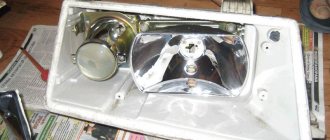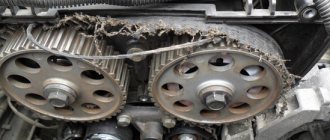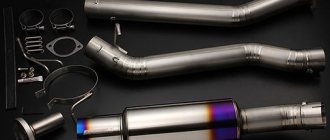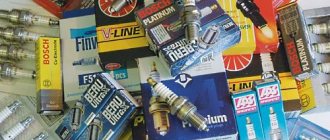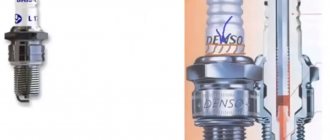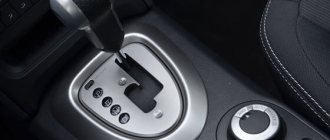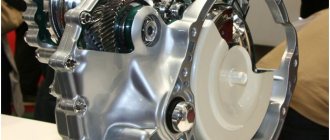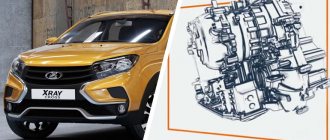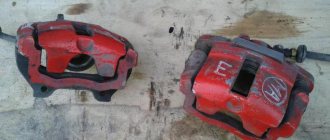What is a CVT transmission, and how does it differ from a traditional transmission? This question may be of interest to both existing car owners with this type of torque transmission and future ones. This type of gearbox implies the absence of fixed gear ratios. This gives a smooth ride and also allows you to use the engine in optimal modes. Another name for such a box is a variator. Next, we will consider the pros and cons of the CVT gearbox, the nuances of its use, as well as reviews from motorists who already own cars with a continuously variable transmission.
What is a CVT and what is its main difference from conventional gearboxes?
CVT transmission - what is it? CVT is an abbreviation of the English name for a variator, i.e. Continuously Variable Transmission, which literally means “constantly changing transmission.” Its main property is the ability to change gears in a different order than we are used to, namely without constant and sequential switching of speeds (steps, gears). In this connection, the variator is rightly called a continuously variable transmission. This is its main distinguishing feature.
The variator belongs to the class of automatic transmissions: it operates in a wide range, gears are switched automatically, and the processes are controlled by an electronic system. Still, the difference between CVT and automatic is significant. What exactly does it consist of?
- A continuously variable transmission is lighter and smaller in size than an automatic transmission.
- It differs from the “automatic machine” in its operating principle. The CVT provides the ideal combination of gear ratio and engine load at every moment (changes occur every second).
The gear ratio is the ratio of the crankshaft speed to the wheel speed. For each gear this figure is individual - gear ratio 4, 5, 6, etc.
CVT saves fuel and increases driving comfort (since the engine operates most of the time at the lowest speeds, while driving at a constant speed).
From an engineering point of view, the variator is the best of all currently existing gearboxes. But don’t rush to make a decision about buying a car with a CVT, not everything is so simple.
LEGENDS AND FACTS
It was not possible to identify a clear winner based on the sum of four tests. It seems that Nissan, which, we recall, has the latest version of the variator (this unit will soon be installed on other models of the Japanese brand), scored half a point more than Subaru. But after consulting, we decided to divide first and second places between these cars. After all, the fractions of a second lost by Nissan during intense acceleration are fully compensated by good results in the Curb test. Mitsubishi lagged behind its rivals just a little. In general, all the cars performed very well and helped dispel some myths about the unviability of CVTs. In normal, everyday use, continuously variable transmissions will not cause any trouble. Of course, if you remember simple truths: crossovers, especially those with a continuously variable transmission, are not SUVs at all! These are city and highway cars that allow you to overcome not very difficult obstacles from time to time. And it’s even more honest to call a single-wheel drive a station wagon with increased ground clearance.
Killing a continuously variable transmission is not easy. Wise electronics will protect the car from a driver who overestimates it and his abilities. Well, we made it! But with many of today's drivers, it probably wouldn't be any other way.
Nissan Qashqai - 1st-2nd places
"Subaru-Forester" - 1-2 places
Mitsubishi Outlander - 3rd place
Testing 4 crossovers with CVTs: chain reactions
When did it appear and what caused the appearance of the variator?
This development was patented in the 18th century. They began to actively use it in the 1950-1980s. Used in equipment that does not have the same power as a passenger car (with electric generators, in chainsaws, snowmobiles, machine tools, sewing machines). For the vehicle, it was necessary to invent a completely different continuously variable transmission mechanism. And over time, engineers solved this problem.
For the first time, a continuously variable transmission was installed on Dutch DAF vehicles comparable to motor vehicles in 1958. Later, in the late 70s, the patent was “inherited” to Volvo. The concern tried to improve the “modest” variator (taking this path was easier than rebuilding the entire production). The resource of the improved CVT model was only enough for 30 thousand km. Years later, the concern refused to use a CVT in its cars.
CVT automatic transmission for DAF 55, chassis removed from frame
In the 80s, the variator was used on Ford cars (Ford Fiesta model), Fiat (Fiat Uno model), and Subaru. And only Subaru managed to overcome the main drawback of CVTs - their fragility (the concern used a metal-containing pusher instead of an elastic belt in the CVT design). Subaru has equipped many vehicles with its own CVT transmission and still supplies its design to other manufacturers.
In the 90s, they began to install a variator on class C cars (i.e., middle class, before that it was installed on inexpensive and practical class B cars). And all thanks to the ongoing search for a more advanced CVT design.
How to properly maintain a car with a CVT
The features of a CVT transmission require the owner to follow certain rules. It is necessary to provide:
- timely oil change. Use lubricant brands specified by the manufacturer or analogues with confirmed characteristics;
- regular computer diagnostics - in order to identify errors in the operation of the mechanism and electrical equipment;
- installation of new units to replace worn ones.
The owner must comply with the maintenance regulations established by the manufacturer and specified in the machine's operating manual.
The operating temperature of the variator must be maintained in the range from 70 to 105 degrees. Exceeding this indicator indicates unsatisfactory cooling of the equipment.
Standard diagram, principle of operation and main elements
A variator in its simplest design (created by Volvo and initially used by the Subaru concern) is a driving mechanism through which rotation is transmitted from one unit to another through an intermediate link. The nodes are two pulleys - wheels with a rim around them, inside which the belt moves. The intermediate link is a V-belt (a type of drive belt) that connects the pulleys to each other. The mechanism is called a “V-belt variator”.
Torque is continuously transmitted to the wheels, and the gear ratio also continuously changes (as engine speed changes, the belt either tightens or loosens).
How difficult is the repair of a CVT Outlander and how is it carried out?
If the variator breaks down, almost all official Mitsubishi dealers offer only a complete replacement of the gearbox, and not repair. But it is worth noting that continuously variable transmissions were considered unrepairable 10 years ago. Today, CVT repairs at a well-equipped service station are carried out without any difficulties, and the cost of work and spare parts does not exceed a third of the price of a new unit.
Often, if the Mitsubishi Outlander CVT transmission malfunctions, it is enough to replace only the oil or worn components - solenoids, belt (chain), bearings, etc. But you should not do such work yourself.
Here, the help of professionals is needed, because the safety of the driver and passengers and the long-term operation of the variator depend on how competently the repair is carried out and what components are installed.
Also, service station specialists will select new original or contract spare parts, since car owners themselves often cannot even find the necessary components for the Mitsubishi Outlander CVT.
Installing incorrectly selected, non-original or low-quality parts will lead to serious problems, repair or complete replacement of the CVT.
Another advantage of service at a car service center is a guarantee on all work performed. After a professionally carried out repair of the variator, Mitsubishi Outlander owners will be able to drive the mileage that was originally set by the manufacturer for the continuously variable transmission without breakdowns.
Our car service offers repair or replacement of a Mitsubishi Outlander variator of any modification and configuration in Moscow. Service station technicians regularly undergo training on the lines of the Japanese automaker and guarantee the quality of the CTV repairs performed. You can get additional information by calling: Moscow - 8, St. Petersburg - 8. We accept calls from all regions of the country.
Diagnostics
First of all, the car service technicians will conduct diagnostics to identify the exact cause of problems in the CVT on the Mitsubishi Outlander. For this purpose, special technological equipment is used. At the diagnostic stage, a scanner is connected to the car’s ECU and the condition of the unit is checked for errors.
The test results will allow you to create an accurate picture of the condition of the continuously variable transmission in order to assess the scope of repairs.
Then the variator is calibrated. This is a process in which the control unit is tuned to optimize the operation of the equipment. Calibration allows you to avoid shocks and vibrations when changing speed and speed up the transmission's response to load changes.
Dismantling and troubleshooting the variator
If, after diagnostics, a decision is made to remove and disassemble the automatic transmission, it is dismantled using lifts, since this is a labor-intensive process. To do this, the variator is disconnected from other Mitsubishi Outlander systems and the ECU is turned off. Then the shafts are removed from the engine, moved to the side or raised.
In some cases, the CVT is dismantled through the lower part of the engine compartment, for which the suspension elements are removed.
The gearbox is placed on a clean surface and disassembly begins for troubleshooting using pneumatic tools, a screwdriver and a rubber hammer. First, remove the crankcase cover and check the condition of the lubricant.
Then the valve body is dismantled and the remaining elements of the continuously variable transmission are disassembled step by step. At the same time, they are visually inspected to identify defects.
What spare parts may be needed for repairs?
Depending on the type of malfunction, the following spare parts may be needed to repair the Mitsubishi Outlander variator:
- stabilizer bushing;
- oil pump valve;
- sets of Teflon rings for cones;
- bearings;
- drain plug gasket;
- CVT cooling kit;
- belt (chain);
- oil seals.
The cost of spare parts for the Mitsubishi Outlander variator needed for repairs directly depends on the exchange rate, whether they are original, new or contract.
Variator oil seal
Oil pump valve
Repair process
Repairing a continuously variable transmission cannot be called too complicated. It depends on which part is damaged. One of the main problems with most CVT breakdowns is belt stretching. In this case, you will need to remove this element after disassembling the box and replace it with a new one, since it can no longer be repaired. The belt model is usually stamped on its surface.
If the variator valve body is faulty (a device that includes mechanical valves and solenoids that regulates fluid pressure in the system), it is enough to remove the cover, wash the equipment and replace the parts.
When the bearings wear out, the operation of the gearbox is accompanied by noise. The destruction of these elements can lead to complete failure of the Mitsubishi Outlander gearbox. Replacing bearings will require complete disassembly of the unit.
Assembly and installation of the variator
After repair, the variator is assembled in the reverse order of disassembly. All fasteners are firmly tightened using a pneumatic tool.
The methods for removing and installing a CVT gearbox are similar to those for an automatic transmission. The only difference is in the size and number of gearbox control drive cables. After installing the box, it is necessary to fill in the working fluid in the amount recommended by the manufacturer, and also check how the clutch driven disc is aligned.
Examination
The serviceability of the Mitsubishi Outlander variator can only be checked while driving. To do this, they use the most popular method - climbing to the curb. The car must drive close to the obstacle, rest its front wheel against it and stop. If, after pressing the gas pedal, the car easily drives onto the curb, then everything is in perfect order.
This test loads the continuously variable transmission and checks the condition of the belt and cones. If the parts are worn out, the car will not drive onto the curb.
Also, when checking the variator, you need to listen to the operation of the unit. It should not knock or make other extraneous noise while driving or changing speed.
It is also important to check the condition of the transmission fluid. To do this, you need to remove the dipstick from the gearbox and drop oil onto a white sheet of paper. The liquid should be transparent, without foreign particles or burning smell.
What determines the cost of repairs?
The total cost of repairing a Mitsubishi Outlander CVT at a car service center depends on several factors:
- modifications to continuously variable transmission;
- prices for spare parts, oil and consumables;
- type of malfunction;
- urgency of work;
- the need for maintenance activities (oil change, filters, etc.).
Modern V-belt variator
The modern design of the CVT gearbox uses pulleys made of heavy-duty metal, and the belt is not an elastic band, but a composite tape made of wear-resistant metal (assembled from strips that are fastened together with staples). The belt is coated with a special coating that protects it from wear and slipping.
One of the pulleys is the drive one. It is connected to the engine's crankshaft (which converts the energy obtained from fuel combustion into rotational energy). The driven pulley is connected to the wheels of the car. The pulleys have a variable diameter (the edges of the rim diverge and converge, then the belt no longer passes inside, between them, but on top).
At low vehicle speeds, the diameter of the driving pulley has a minimum value, and the diameter of the driven pulley has a maximum value. At medium speed the diameter is the same. At maximum, the size of the master increases, and the size of the slave decreases. By changing the size of the pulleys, we change the gear ratio.
The mechanism is “controlled” by an electronic system, relying on information from numerous sensors (shaft speed, wheel rotation, information from the transmission itself).
Main elements of the variator
The pulleys and belt are only part of the design of modern CVTs and are called V-belt drives. The structure of a CVT (continuously variable transmission) is much more complex; the unit housing contains many other elements.
Let's remember what we already know. Torque from the engine is transmitted to the input shaft and then to the drive pulley. This process may involve a hydraulic transformer (not available on all models). The torque converter disconnects the transmission from the engine and transmits force from the shaft to the pulley.
After the torque converter, the force passes to the belt, and from it to the driven pulley. Then, using a planetary gearbox, the torque is transferred to the secondary shaft. And the car moves forward. In order for the car to move backward, the planetary mechanism or reverse mode is activated (changes the direction of rotation of the shaft).
The design also includes a differential, which distributes the load across the wheels (torque is transmitted to the differential from the intermediate shaft).
The electronic system, which manages all processes inside the CVT, reads information from the sensors and changes the operating mode of the CVT. The sensors are installed where you can quickly obtain information about the speed of rotation of the shafts, the temperature of the working fluid, and the position of the selector (gearbox knob). The electronics takes into account the load on the engine, the speed of the car, the position of the gas pedal and much more.
Some CVT models provide the ability to manually change speeds in steps, like on an automatic transmission. In others, only special modes may be present: “sports”, “economical”.
All described elements are placed in one housing.
Working fluid
The diameter of the pulley changes due to the movement of the disks. Movement is possible due to the pressure of the working fluid - oil (hydraulic system). But this statement is only true for the drive pulley. On the driven disks, they move from the belt tension and due to the return spring.
A special oil has been developed for CVT. The fluid exhibits frictional properties (helps reduce friction and wear of rubbing surfaces) at its operating temperature (60-70 degrees above zero).
It is permissible to fill only original fluid (no substitutes).
When driving at a speed of more than 150 km/h, the oil overheats (operating temperature increases to +80 degrees). Overheating should not be allowed; it will negatively affect the service life of the variator (CVT). The liquid is cooled using an additionally installed oil cooler (radiator).
It is necessary to monitor the oil level: if the amount decreases too much, the belt will slip. And, in order to prevent clogging, the fluid must be changed every 60-150,000 km (every five years).
Possible operational problems
In practice, owners of cars equipped with a CVT transmission face three main problems.
- Wear of cone bearings .
The reason for this phenomenon is trivial - wear products (metal shavings) or debris get onto the working surfaces. The car owner will be told about the problem by the sound of a hum coming from the variator. This can happen at different mileages - from 40 to 150 thousand kilometers. According to statistics, the Nissan Qashqai is very guilty of this. To avoid such a problem, it is necessary to regularly change the transmission oil (in accordance with the recommendations of most automakers, this should be done every 30...50 thousand kilometers). Reducing pump and valve - Failure of the oil pump pressure reducing valve . This will be indicated to you by jerking and twitching of the car both during starting and braking, and during calm, even driving. The cause of the breakdown will most likely lie in the same wear products. Due to their appearance, the valve jams in intermediate positions. Consequently, the pressure in the system begins to jump, the diameters of the drive and driven pulleys become out of sync, and because of this, the belt begins to slip. During repairs, the oil and belt are usually changed, and the pulleys are ground. Prevention of malfunction is the same - change the transmission oil and filter on time, and also use high-quality oils. Remember that CVT type transmission oil must be filled into the variator (it provides the necessary viscosity and “stickiness”). CVT oil is distinguished by ensuring stable operation of the “wet” clutch. In addition, it is more sticky, which ensures the necessary adhesion between the pulleys and the drive belt.
- Problems with operating temperature . The fact is that the variator is very sensitive to the range of operating temperatures, in particular to overheating. A temperature sensor is responsible for this, which, if a critical value is exceeded, switches the variator to emergency mode (sets the belt to the middle position on both pulleys). For forced cooling of the variator, an additional radiator is often used. To avoid overheating the variator, try not to drive at maximum or minimum speed for a long time . Also, do not forget to clean the CVT cooling radiator (if your car has one).
Other types of variators
There are structurally different types of variators: V-belt (the most common), toroidal and chain. We studied the first one in detail because it is the most common. The second is installed on all-wheel drive and rear-wheel drive vehicles. The latter is used on heavy vehicles, since it is the most reliable.
Toroidal CVT gearbox
A toroidal gearbox is a more complex mechanism. In it, the role of pulleys is played by disks elongated in the shape of a cone on one side. The disks are directed towards each other with sharp ends. The one located on top is the leader. Below is the follower.
The role of the belt is performed by rollers. They are located on opposite sides between the disks. And they move along the curves. Synchronously rising up, they increase the gear (the speed of the car increases, the torque decreases). When lowered to the driven disk, the gear decreases. Positioned in the middle, they issue a direct transmission. The force is transmitted due to friction (rollers rub between the disks).
Belt CVT is used more often, but toroidal is more reliable. However, it has a significant drawback: it cannot be repaired (if it breaks, you have to replace it with a new one).
Chain variable transmission
Chain is a type of V-belt, which is practically no different from the “prototype”. In the variator they only replaced the belt with a steel chain. Such a device has a variator called Multitronic, created by the Audi concern. It has an increased service life, an increased level of strength, and the chain variator can withstand loads better. Therefore, it is more often used on trucks.
The chain variable speed transmission is not widely used because it produces a lot of noise (the level is too high).
CVT device
The cvt gearbox is built on three basic elements that carry out its entire operating principle:
- driven friction wheel output;
- the driving input friction wheel, which is connected to the crankshaft and rotates the driven friction wheel and transmits energy to the driveshaft;
- a high-strength belt made of rubber or metal that connects friction wheels.
Both friction wheels can be moved apart using a load clutch. They are connected to each other by a metal belt. The variator belt occupies a special place in the operation and design. It is highly complex and technologically advanced. The belt contains up to 12 high-strength steel strips, making it non-slip and providing high torque. Each of the steel belt strips consists of trapezoid-shaped metal plates that run transversely. This shape ensures close contact with the friction wheels, thereby transmitting torque. Some developers use a wide chain with plates instead of a belt, the edges of which cling to cones.
Working principle of CVT
Modern CVTs
Nowadays, most cars from Japanese and German brands are equipped with continuously variable transmissions. Because their production is cheaper.
The world's leading manufacturers of automatic automatic transmissions, including CVTs, are ZF, Aisin, and Luk. These manufacturers create “automatic machines” for automakers from Japan, Europe and the USA. For example, the Ford concern uses ZF products, and Luk supplies components for Subaru CVTs.
Also, many global automakers have established CVT production at their factories. Their developments are patented and produced under their own names. Some of these CVTs do have unique features that affect the operation of the unit. The essence of others is not too different from what was previously invented.
The most famous CVT models:
- Japanese – X-tronic (Nissan), Lineartronic (Subaru), Multimatic (Honda), Multidrive (Toyota) – Japanese CVTs are less “capricious”, the undisputed leader among them is Multidrive (Toyota);
- German - Multitronic (Audi), Autotronic (Mercedes-Benz);
- American - Ecotronic (Ford) and Durashift CVT (Dodge).
In our country, the following car models with a CVT have become widespread: Honda HR-V and Civic, Nissan Primera, Audi models.
Features and differences of the X-tronic Nissan variator
The cars of the Nissan-Renault alliance are equipped with branded X-tronic CVTs produced by the Jatco subsidiary: on the Renault Captur, Nissan X-trail and Qashqai crossovers, etc.
Nissan's continuously variable transmission (CVT) is a type of V-belt CVT, but is a modified version of it. The reason for the modification was the desire of the automaker to deprive the CVT of its typical shortcomings.
Engineers made changes to the V-belt drive design (they made thinner pulleys and reduced the flexibility of the belt). The degree of reliability of the variator is increased by reducing the pressure between the belt and pulleys. Friction losses decreased by a third. As a result of the changes made, a lighter gearbox was obtained.
The main innovation is an additional planetary gear. Unlike conventional CVTs, the X-tronic gear ratio is higher – increased to 7.3/1.
X-tronic works in tandem with powerful engines; thanks to the adaptive electronic control system, the variator “adjusts” to any road conditions. Hence the recognition of experts: the X-tronic continuously variable transmission is a promising development that changes for the better the general idea of CVTs.
In turn, drivers in numerous positive reviews note: CVT from Nissan works quietly, the car with it accelerates smoothly and rapidly, thanks to the variator, the feeling of comfort does not leave during the entire drive.
But there are some drawbacks here: a car with an X-tronic variator slips in difficult road conditions (snow, mud). And in the event of a breakdown, the same difficulties with repair arise.
Lineartronic Subaru is one of the most reliable CVTs
Since 1984, Subaru began to use ECVT CVTs, forgotten since Volvo’s attempts, and significantly improved them. Subaru engineers equipped the CVT not with an elastic belt, but with one made of metal links. The mechanism also received a torque converter, sensors, and an electronic system. In this CVT, only the diameter of the drive pulley changed. The experts were amazed - the service life of this variator turned out to be many times longer. And the automatic mode demonstrated all the advantages of automatic transmission. At one “wonderful moment,” the concern decided to abandon the ECVT installed on the Justy model, and developed a CVT for Vivio, controlled exclusively by electronics. A little later, Subaru engineers tried to improve the performance of their first CVT; the new model was called iCVT and installed it on the Pleo car. An attempt to install iCVT on more powerful cars was unsuccessful.
In 2009, a new CVT model appeared called Lineartronic, based on the developments of the famous auto parts manufacturer - LuK. Today, Lineartronic CVTs from Subaru are installed on the brand’s models: Outback, Impreza, Legacy sedans, Exiga compact van, Forester crossover.
Cars with turbocharged engines are equipped with an upgraded version of the TR690, produced since 2009, and the rest are equipped with a new variator TR580 (New Lineartronic). CVT versions differ in design and size.
Subaru CVTs are considered the most reliable because they use a chain instead of a belt (a type of V-chain variator). The LuK company still supplies Subaru with a chain and guides for the Lineartronic variator. The chain is assembled from 900 plates and is flexible. With it it became possible to use pulleys of smaller diameter.
Due to the difference between the width of the pulleys, the CVT exhibits a record maximum gear ratio of 6.32. Also, a smaller bending radius made it possible to reduce internal stress and minimize the risk of deformation and friction of chain parts.
A smooth but confident start (even when going uphill) is ensured by the operation of the torque converter. It doubles the torque coming from the engine, and then (at 10 km/h) it is blocked (which eliminates unnecessary energy losses).
Despite its impressive potential, Lineartronic has compact dimensions: the entire CVT structure is significantly smaller than a belt drive.
The 4WD system is integrated into the variator housing. “Electronics” allows you to distribute torque between the axles, depending on road conditions; ensures vehicle stability and controllability.
The CVT electronic control unit is located outside the variator, is not subject to vibration or temperature changes, and therefore demonstrates high reliability.
In light of these features, the Lineartronic chain transmission turns out to be 5% more efficient than a standard V-belt gearbox. Saves up to 8% fuel (compared to an automatic transmission) - this is a serious achievement, considering that 1% savings in the automotive world is already a success. The operating life of Lineartronic is enough for 200-250 thousand km. The CVT can last longer if overhauled.
True, the Lineartronic variator is not intended for aggressive driving (components and parts wear out quickly due to sudden changes in driving modes). Towing on a cable with the engine not running is also not permissible. The service life and smooth operation of the Subaru CVT is affected by the quality of the fluid specially designed for the chain variator.
Features Multitronic Audi
The audio is produced by a variator with so-called virtual gears: each gear corresponds to a certain position of the conical wheels. During acceleration, the CVT maintains high revs. “Automatic” only works when the sport mode is turned on. The gear is selected by the driver.
This CVT has been produced since 2005 under the name Multitronic. Refers to the type of chain variators. Installed in premium class cars - A6, A8.
The design includes a strong chain - assembled from 1025 plates; links of different sizes are used to reduce noise levels. And also pulleys with hydraulic cylinders (the first presses the chain to the pulley, the second regulates the gear ratio). Compressing the pulleys avoids slipping when downshifting (or upshifting).
The Audio clutch device (in CVT) uses a multi-plate clutch instead of a hydraulic system, which makes it possible to combine smooth movement with quick start and acceleration.
Multitronic has a planetary gear (for reversing). The control system allows you to adjust the speed of reversing.
Previous Audi CVTs, produced since 1996, were “famous” for constant failures in the electronic control system. The chain was not very strong. But Multitronic is far from ideal. Audi engineers began to refuse to use it.
Principle of operation
Based on the decoding of the abbreviation, this type of transmission is based on the principle of continuous gear shifting without driver intervention. The very principle of operation of the variator has been used before in snowmobiles, some machine tools and chainsaws. But due to the heavy loads in cars, such a device needed to be modified. As mentioned above, the main element that ensures the vehicle moves is a steel belt, consisting of many rows of high-strength steel with wedge-shaped serrations. The driven friction wheel is connected to the engine; a belt goes from it to the driving friction wheel, which provides speed to the driving pair of wheels. Both friction wheels can expand and contract. The expansion and contraction of the driving friction wheel is controlled by an electronic control unit, and the second wheel expands when subjected to greater pressure from the first wheel. Since the steel belt, thanks to the serrated protrusions, can be in any position: on the cone of the expanding and contracting wheel, this provides the principle of multiple gears depending on the speed and load at the current moment of use. In fact, the work of the variator fits into three main steps:
The first step is when the engine starts and the drive begins to move, the drive wheel in the variator is narrowed as much as possible, and the driven wheel is widened. The second step is to reach an average speed of approximately 100 km/h, both wheels are widened at the same (average) level. The third step is to achieve maximum speed (gas pedal to the floor), the driving friction wheel expands as much as possible, and parallel to it, the driven friction wheel, which ensures rotation of the car drive, narrows as much as possible.
Important: “If you press the gas pedal all the way from the start, the friction wheels will immediately go from the first step to the third, providing a quick increase in speed without a jerk.”
What's good about a variator?
How to determine which gearbox is installed in a car
Modern gearboxes, including robotic gearboxes, are very similar in appearance: even a continuously variable one imitates an “automatic” (it has a selector and a standard speed scale). And yet, it is possible to determine whether a CVT or another gearbox is installed in a vehicle. Pay attention to:
- information in the car documents,
- descriptions of your car model from the Internet,
- plate located on the vehicle body.
Information about the transmission is contained in the vehicle operating instructions and technical documentation. You can also find out about the installed device by the vehicle’s vin number (the identification number is indicated in the vehicle certificate and in the vehicle passport). There are special web services that provide information about the vehicle’s equipment using the VIN code.
It is not always worth resorting to paid online services (not everyone will provide the necessary information). It's worth looking up information about the transmission using a search engine. Most models from different brands are described in detail on the Internet. But, if there is no information about the transmission, there is one more option - the designations on the plate.
The designations are a set of numbers and letters, which the sales consultant will help you decipher (if you need to purchase additional spare parts). This information is enough to order components. If suddenly the plate is lost or the letters on it are erased, the same one is located on the body of the device itself. The technician will learn about the transmission when he gets to the housing (in case of maintenance or repair).
Subaru engine compartment plate
Audi engine compartment plate
Nissan engine compartment plate
How to drive a car with a CVT gearbox correctly
To extend the life of the CVT transmission, it is necessary to properly use a car with this box design. The owner should refrain from driving off-road. Wheel slipping when driving on snow or mud reduces the service life of the mechanism.
You should not suddenly run into obstacles, and switch from mode D to R as little as possible in order to reduce the wear rate of components.
You cannot tow a car with a CVT transmission, since forced movement damages the transmission. If towing is required, the drive pair of wheels must be suspended.
You should not use the car as a tractor or transport a trailer that weighs more than the established standards. More details about the features of driving a car with a CVT transmission design can be found in a separate article.
Pros and cons of a continuously variable transmission
Cars with CVTs are primarily famous for their high efficiency and level of comfort while driving: smooth ride, fast acceleration, imperceptible changes in speed, absence of jerks. CVT ensures optimal engine speed and maximum torque. The engine does not stall at traffic lights or when driving in traffic jams. Going uphill is faster, without slowing down.
These are the main advantages of the CVT gearbox; unfortunately, there are more disadvantages.
- There is an opinion that CVT often fails. However, this is not entirely true: problems with the variator do not arise while the warranty on the new car is valid. CVTs often fail if the car owner violates the operating rules recommended by the manufacturer (subjects the car to high loads, preferring aggressive driving).
- In addition to replacing the expensive original oil, filters are also required (every 30 thousand km).
- Due to their design features, the scope of application of CVTs is limited: they cannot be used in vehicles with powerful engines (no more than 220 hp). It is also unacceptable to operate the car at high speeds.
- Another restriction concerns towing: a car with a CVT can only be towed by a tow truck.
Experts' verdict: savings or reliability?
At the end of the article, I would like to answer the main question of car owners - which is better, CVT or automatic? From an economic point of view, it is more profitable to buy a car with a CVT, since it is the continuously variable transmission that ensures optimal fuel consumption. And the engine paired with a variator runs longer (experiences less load).
But if we take into account other factors (short service life compared to a gearbox, high price of the original oil, cost of possible repairs), buying a car with a CVT no longer looks so rational.
Unfortunately, repairs are expensive. The cost increases significantly if there is a need to repair the torque converter or it turns out that the necessary spare parts are not available (must be ordered). Often there is talk of a complete replacement of the CVT: CVTs are not durable - 150-200 thousand kilometers (hence the low demand in the secondary market). In addition, there are few craftsmen capable of carrying out such complex repairs and complete replacements (accordingly, the cost of their services is higher).
Therefore, both from the point of view of reliability and from the point of view of efficiency, it is more profitable to purchase a vehicle with an automatic or manual transmission (such cars are not sold much more expensive). The only exceptions are some models of CVTs, which are distinguished by an increased degree of reliability and improved performance characteristics (X-tronic, chain Lineartronic, chain Multitronic with adaptive “Sport” mode).
Which car should you prefer? It depends on you: your financial capabilities (are you considering buying a new car or looking on the secondary market, are you ready to invest in expensive maintenance), how long do you plan to drive, how important is it to profitably resell the car, what driving style do you prefer. Cars with CVT are suitable for responsible drivers who prefer measured driving in the city or on the highway, and who highly value driving comfort.
Reviews about CVT gearbox
Finally, we have collected for you real reviews from car owners whose cars are equipped with a CVT. We present them to your attention so that you have the clearest possible picture of the appropriateness of your choice.
| Positive reviews | Negative reviews |
| You need to get used to the variator. I had the subjective impression that as soon as you let go of the gas, the car stops much faster than with an automatic transmission (most likely this is because engine braking occurs). This was unusual for me, I like to drive to a traffic light. And on the plus side, the dynamics on the 1.5 engine are amazing (not compared to the Supra, but compared to regular cars with 1.5) and fuel consumption is low. | Everyone who praises the CVT, no one can sanely explain why it is better than the modern, also smooth 6-7-speed real hydromechanics, i.e. the answer is simple: nothing, even worse (written above in the article). It’s just that these people bought a CVT not because it is better than an automatic, but because the car they decided to buy did not come with a real automatic. |
| A CVT is more economical than an automatic (I compare it not with a Selick but with any other car with a 1.3 engine | The CVT does not inspire hope. An interesting development, of course. But, given that the entire global auto industry is moving away from improving the reliability of modern units, you can’t expect anything from variable speed drives (as well as from robots). Unless we switch to a consumer attitude towards a car: I bought it, drove it for 2 years under warranty, drained it, bought a new one. Which is exactly what they are leading us to. |
| Pros - faster and more confident acceleration compared to automatics and manuals (unless you are a master of sports in auto racing with a manual). Economical (Fit-5.5 l, Integra-7 l, both on the highway) | Why do you need a CVT when a “classic” automatic was invented long ago - smooth and super reliable? Only one option arises - to reduce reliability and make money on the sale of spare parts. And so, like, 100 thousand. The car has passed - that’s it, it’s time to go to the trash heap. |
| Last winter I drove a Civic with a CVT and had no problems on ice. The CVT is really more economical and dynamic than the automatic. The main thing is that you get it in good condition. Well, a little more expensive service is the price to pay for driving pleasure. | In short, CVT = hemorrhoids, a marketing cartoon for disposable cars. |
| Seventh year on the CVT - excellent flight! | The old machine gun is as reliable as an AK47, nafik these variks |
As you can see, most people who have tried driving a CVT at least once, if possible, do not refuse this pleasure further. However, it is up to you to draw your own conclusions.
Results
The variator, although more complex and expensive to maintain, is still by far the best transmission for cars with an internal combustion engine. And over time, the price of cars equipped with it will only decrease, and the reliability of such a system will increase. Therefore, the described restrictions will be removed. But today, do not forget about them, and use the car in accordance with the manufacturer’s recommendations, and then the SVT box will serve as faithfully for a long time as the car itself.
Question answer
Owners of Mitsubishi Outlander often ask questions about CVTs and their repair. The most popular ones are listed below.
How to understand that the variator cannot be repaired
If the driver of a Mitsubishi Outlander begins to notice problems with the operation of the CVT gearbox (grinding, humming, car stopping, jerking during acceleration), you must contact a service station. Car service technicians will diagnose and troubleshoot the variator and determine whether the unit is repairable or requires a complete replacement.
Is it possible to install a used rebuilt CVT on a Mitsubishi Outlander?
Often, if a continuously variable transmission breaks down, it is easier to replace it rather than repair it. The ideal option is to use a new branded unit for replacement. But for many Mitsubishi Outlander car owners, the price of the issue becomes an obstacle - a new CVT is expensive.
But in this case, there is a good alternative - replacing it with a used reconditioned gearbox. It is recommended to change the unit only at a car service; you should not do it yourself, even in order to save money.
How much does a new CVT cost for an Outlander?
The price of a CVT depends on the exchange rate and the modification of the Japanese SUV. For example, a new CVT with a 1-year warranty on Outlander 3 costs an average of 240 thousand rubles. In comparison, a restored CVT for the same model with a 6-month warranty will cost 110 thousand rubles.
Is it possible to install a CVT of another model on a Mitsubishi Outlander?
Many global automakers install CVTs from the Japanese company Jatco on their cars. But each manufacturer assigns its own internal codes to CVT (continuously variable transmission model names). As a result, confusion arises when people talk about different CVTs and do not realize that in fact they are the same model, just with a different name.
It follows that before changing the CVT, it is necessary to study its modification in detail.
Is it possible to install an additional radiator?
One of the disadvantages of some versions of the Mitsubishi Outlander is the absence of a radiator for cooling the continuously variable transmission. As a result, at speeds above 140 km/h, the transmission fluid overheats. To prevent this from happening, by contacting a car service, you can install an additional radiator on the variator.
It is better not to repair the Mitsubishi Outlander CVT in a regular garage, since it is not equipped with sufficient equipment and tools for this. At home you can only change the oil. For everything else, it is better to contact specialized service centers.
How often do you perform maintenance on your car? Write in the comments. Save the article to your bookmarks so you can always return to the information you need.
If problems arise with the variator, specialists from the “Cvariator Repair Center No. 1” will help you solve it. You can get additional free consultation and diagnostics by calling: Moscow - 8 (495) 161-49-01, St. Petersburg - 8 (812) 223-49-01. We accept calls from all regions of the country. Consultation is free.
Is it possible to repair the CVT on a Mitsubishi Outlander yourself?
CVT repair requires special knowledge and training. Without studying the design of the unit, without possessing the skills and without special equipment, it is better not to start such an undertaking yourself, but to contact a service station.
Of course, there are garage specialists who themselves undertake to repair the CVT Mitsubishi Outlander, but with incompetent actions, as a rule, they only aggravate the already deplorable condition of the unit. According to statistics, in 90% of cases of self-repair of a continuously variable transmission, it quickly fails and must be completely replaced.
Common mistakes made when repairing a variator with your own hands:
illiterate diagnosis;
use of inappropriate, often cheap spare parts and consumables;
filling with non-original transmission fluid;
errors during disassembly, assembly and installation of the unit.
